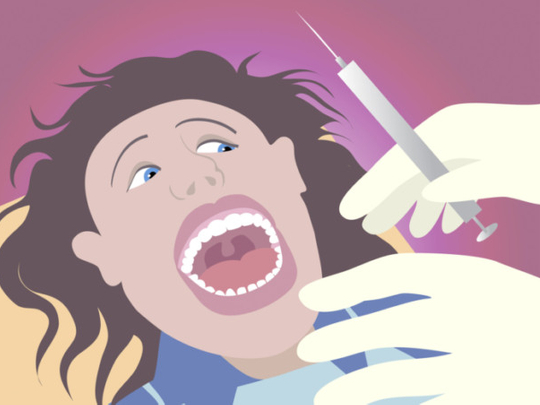
The whir of a dentist’s drill might bring on the shakes and a racing heart, but what happens in the brain has long been a mystery.
Now researchers in Japan believe they are closer to an answer after scanning people’s brains while playing them sounds of dental drills and suction instruments.
People who were terrified of visits to the dentist showed marked differences in their brain responses compared with those who were more relaxed at the prospect, according to work reported at the Society for Neuroscience meeting in San Diego on November 10.
Unravelling how the brain reacts to the sounds, particularly in the most anxious dental patients, could help scientists assess different ways to make patients more at ease, by seeing how they alter neural activity, said Hiroyuki Karibe at Nippon Dental University in Tokyo.
“As a paediatric dentist, I’ve seen many patients since 1987, and from my clinical experience, I found that the sound of drilling can evoke anxiety in dental patients,” Karibe said. But he added that no one had ever directly investigated how the sounds of dental instruments affected people’s brain activity.
Working with psychiatrists, Karibe asked 21 women and 13 men aged 19 to 49 to complete a survey that measured how much they feared a trip to the dentist. The survey posed 20 questions, such as “do you get tense during dental treatment?” and “do you feel anxious when you hear the dental drill?”. The volunteers answered on a scale from one to five, with one being “not at all” and five being “very much”.
Karibe divided the volunteers into high- and low-fear groups according to their scores on the survey. He then scanned the participants in a functional magnetic resonance imaging machine (fMRI) while playing them a series of sounds, including screeching dental drills and rasping suction tools.
“All of the participants were isolated in the fMRI room when they listened to the dental sounds, so we couldn’t see if they responded visibly or audibly to the dental sounds, but we could recognise their responses from their brain activity,” Karibe said.
People in the low-fear group were not overly anxious about going to the dentist. When they heard dental sounds, parts of the brain called the left and right superior temporal gyri responded more than when they heard neutral sounds. This, Karibe said, means that dental sounds triggered more activity in the primary auditory areas of the brain.
Anxious people responded differently. Instead of a surge of activity in the auditory areas of their brain, Karibe said he saw a more intense response in a region called the left caudate nucleus, which may play a role in learning and remembering the sounds of the dental instruments.
“We believe the findings can be applied to assess the effectiveness of interventions such as cognitive behaviour therapy for patients who have a strong fear of dental treatment,” Karibe said.
About 10 per cent of the population have severe anxiety about trips to the dentist, and many put off their visits until they have toothache or another emergency, such as a dental abscess. The behaviour can lead to a negative cycle of events, with patients becoming ever more afraid because emergency treatment can be more traumatic.
Martin Tickle, professor of dental public health at Manchester University, said dental anxiety was more common in children whose parents feared the dentist, and who had a history of having teeth extracted.
But a recent survey by Tickle found that pain is actually quite rare in dental surgeries. He compiled reports from 451 adults visiting dentists in the northwest of England and found that 75 per cent of patients reported no pain at all during their visits. Those having the most invasive procedures, such as tooth extractions and root canal treatment, reported some of the higher pain scores, but even many of these claimed to experience no pain at all.
“The strongest predictor of pain during dental procedures was dental anxiety. Anxious patients were four times more likely to experience pain than non-anxious patients after controlling for other factors,” Tickle said.
“I don’t think the answer for the NHS lies with giving dentally anxious patients brain scans. The first thing we need to do is prevent dental caries in young children to stop them having to have extractions, as the most common reason why children have a general anaesthetic is to have decayed teeth extracted,” he added.
“We also need to improve the amount and quality of research looking at how to effectively manage children and adults who are dentally anxious and provide guidelines for dentists on how to use research-proven interventions.
“For more severe phobic cases we again need to develop the evidence base for how best to manage these patients in more specialised services, for example, through talking therapies,” Tickle said.
–Guardian News & Media Ltd











